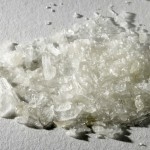Methamphetamine
Classification: Psychoactive stimulant
Commercial Names: Desoxyn, Pervitin, Philopon, Anadrex, Syndrox
Common Names/Nicknames: Meth, crystal, crystal meth, ice, chalk, crank, glass, speed
Active Compound: Methyl-alpha-methyl-phenyl-ethylamine
Found in: Prescription methamphetamine, methamphetamine crystals, injectable methamphetamine
Mode of Consumption: Ingestion, inhalation (smoking), insufflation, injection
DEA Scheduling/Legal Status (in US): Schedule II, legal with prescription with restriction (prescription methamphetamine), illegal in all states (crystal form).
Effects:
Euphoria, increased activity, anorexia, dilated pupils, skin flushing, increased libido, hallucinations
Risks:
Acute: Headache, dry mouth, teeth grinding, restlessness, twitching, diarrhea, accidental injury, hostility, increased heart rate, hypertension, hyperthermia, convulsions, coma, fatal overdose
Chronic: addiction, tolerance, withdrawal, dental damage (bruxism), amphetamine psychosis, paranoid schizophrenia, depression, suicidal tendencies, brain damage, increased risk of Parkinson’s disease
Inhalation (smoking): lung damage, “meth mouth;” Insufflation: nasal septum damage
Dangerous Drug Combinations:
Potentially fatal combination with other stimulants, depressants/sedatives, and seizure medications. Potentially dangerous mix with acetaminophen/paracetamol (Brand names: Tylenol, Triaminic, Panadol) and medications with risk of seizure.
Special Considerations:
Methamphetamine can be synthesized using make-shift laboratories and readily available chemicals. However, the byproducts and solvents of these reactions are known to be incredibly dangerous and volatile, often leading to fires and explosions.

And remember, if somebody needs help, play it safe and call for medical assistance.
“Students may bring an intoxicated or drug-impaired friend to University Health Services or to a hospital, or seek assistance from College residential life staff or HUPD, and by doing this, neither they nor the friend will face disciplinary action from the College for having used or provided alcohol or drugs.”
The Amnesty Policy
Harvard College Student Handbook
Buzzed: The Straight Facts About the Most Used and Abused Drugs from Alcohol to Ecstasy (Third Edition), by Cynthia Kuhn, Scott Swartzwelder, andWilkie Wilson. Published 2008 by W. W. Norton & Company.
National Institute on Drug Abuse (NIDA), part of the National Institute of Health (NIH) of the U.S. Department of Health and Human Services. http://www.nida.nih.gov/DrugPages/
U.S. Drug Enforcement Agency (DEA), part of the U.S.Department of Justice. http://www.justice.gov/dea/
Erowid Organization http://www.erowid.org/
